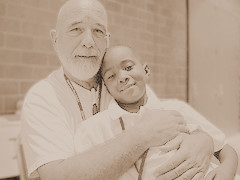[cross-post from AmericanGrace.org Blog]

Woody Allen on Tonight Show ('65); photo by John McNab, marked for cropping
While I respect Woody Allen greatly as a comic, interviewed by the New York Times, he said recently:
“To me there’s no real difference between a fortune teller or a fortune cookie and any of the organized religions. They’re all equally valid or invalid, really. And equally helpful.”
Brad Hirschfield from the Washington Post’s On Faith column ponders:
“Is he wrong or is he right? Of course, the answer is yes. In many ways there are no differences between any of the faiths and practices which help us in our lives, especially in the most significant sense – that they help us. But in other ways, there are profound differences.
“Fortune cookies and fortune tellers help only the individual who avails themselves of their respective insights, or is that ‘insights’? – you decide. The organized religions to which Mr. Allen compares them should also connect us to things beyond ourselves and our own immediate needs.”
The question of whether all religions are equally valid or invalid is a matter for theologians, and we’ll leave that debate to them. As for the latter, that any religion is equally helpful to one another or to fortune cookies, American Grace does have a lot to say. We do generally agree with Woody Allen that most of the religions we looked at seemed to be equally helpful. Some of the benefits, as Hirschfield notes, extend just to the practitioners, and some extend to the broader community. We discuss in American Grace evidence that those who are more religious join more secular causes, give more to secular causes, volunteer more for secular causes, are happier, and are more engaged in their community (compared to their demographic twins that are not religious). [Read the details in American Grace which appears in bookstores around the country and on Amazon in October.]
As to Woody’s quip that religions are as helpful as a fortune cookie, we have to respectfully disagree (backed by a significant marshaling of the evidence). If Chinese restaurant-goers have found fortune cookies as powerful as religion, we’d like to know about them…
Elsewhere in the interview, Woody says about his new movie (You Will Meet a Tall Dark Stranger):
“I was interested in the concept of faith in something. This sounds so bleak when I say it, but we need some delusions to keep us going.”
We don’t believe it is delusion that is doing the heavy lifting, especially given the fact that we find that it is having friends at church rather than religious beliefs or theology that predicts religious adherents being better citizens and happier. If it’s merely about delusion, why aren’t the people quietly praying at home or reading their religious texts at home equally engaged? Faith might “keep us going”, but it is being in vibrant religious communities that keeps us engaged.
Read American Grace in October and see which argument convinces you more…









 Driven by concern that 73% of Americans do not volunteer, the developers of
Driven by concern that 73% of Americans do not volunteer, the developers of 